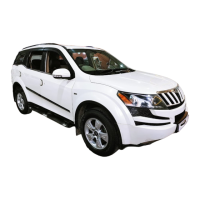
Do you have a question about the Mahindra 2016 KUV100 K2 and is the answer not in the manual?
| Brand | Mahindra |
|---|---|
| Model | 2016 KUV100 K2 |
| Category | Automobile |
| Language | English |
Congratulates the owner and emphasizes reading the manual for safe operation and maintenance.
Explains the meaning of danger, warning, caution, and notice symbols used in the manual.
Provides essential safety guidelines and instructions for safe vehicle use and maintenance.
Lists features available across different KUV100 variants for easy comparison.
Details recommended lubricants and their capacities for diesel variants.
Details recommended lubricants and their capacities for petrol variants.
Provides detailed dimensions and weights of the vehicle for reference.
Lists the specifications for various bulbs used in the vehicle's lighting system.
Explains the function of fuses and relays and how to identify them.
Identifies and labels various components visible from the front of the vehicle.
Identifies and labels various components visible from the rear of the vehicle.
Identifies and labels the various controls and displays on the instrument panel.
Details the layout and components of the instrument cluster for specific variants.
Details the layout and components of the instrument cluster for other specific variants.
Provides an overview and identification of various warning and tell-tale lamps.
Explains the meaning and action for each warning lamp symbol.
Guides on how to sit correctly in the driver's seat for comfort and safety.
Provides comprehensive safety warnings and instructions for seat belt usage.
Guides on how to properly fasten the seat belt for maximum protection.
Explains how to secure a child using seat belts and child restraint systems.
Guides on installing child restraint systems using ISOFIX and top tether.
Describes the types and locations of airbags in the vehicle.
Explains the airbag system malfunction indicator lamp and its meaning.
Describes the process of airbag inflation and deployment during a collision.
Explains the different types of keys, their operation, and the key number tag.
Describes how to lock and unlock all doors simultaneously from inside or outside.
Explains the operation of the RKE system for locking, unlocking, and security features.
Outlines the features and operation of the engine immobilizer system for theft prevention.
Explains the operation of power windows and the window lock switch.
Describes the features and adjustment of the outside rear view mirrors.
Introduces lighting controls, including turn signals, lamps, and fog lamps.
Describes the feature that keeps headlamps on for a short duration after exiting the vehicle.
Introduces interior lamps, including roof, mood, boot, and puddle lamps.
Explains the use and location of 12V power outlets for accessories.
Introduces the wiper control stalk and details its functions.
Details the instrument cluster layout and its various indicators.
Provides a comprehensive overview of all warning lamps in the instrument cluster.
Introduces the Engine Stop/Start System (ESS) and explains its operation.
Explains the Electric Power Steering (EPS) system, its operation, and troubleshooting.
Details the audio controls mounted on the steering wheel for driver convenience.
Describes the vehicle's brake system, including disc and drum brakes.
Explains how to apply and release the parking brake correctly.
Explains the function and operation of the Anti-Lock Brake System (ABS).
Introduces the HVAC system and its main components and functions.
Explains the function of HVAC control buttons and knobs for cabin climate.
Details the different air distribution modes for directing airflow.
Explains the selection between fresh air and recirculation modes.
Explains the function and replacement of the cabin air filter.
Provides steps for achieving rapid cabin cooling.
Provides steps for achieving rapid cabin heating.
Explains how to clear fog and frost from windshields and windows.
Provides essential safety checks before starting the vehicle.
Explains the different positions and functions of the ignition switch.
Guides on the correct procedure for starting the vehicle's engine.
Offers general precautions and tips for safe driving.
Explains fuel recommendations for petrol and diesel variants and fuel handling.
Offers practical tips to improve vehicle fuel economy.
Explains how to read tyre information and sidewall markings.
Describes the tyre label and its importance for inflation and vehicle details.
Explains the importance of correct tyre pressure for safety and economy.
Provides recommendations for tyre rotation to ensure even wear.
Guides on the correct procedure for tightening wheel bolts.
Provides checks to perform when the vehicle does not start or cranks slowly.
Explains how to handle vehicle overheating and cool the engine down.
Guides on the correct procedure for jump-starting a vehicle with a dead battery.
Explains towing equipment and procedures for safe vehicle transport.
Explains the Limp Home Mode function in case of critical system failure.
Provides general information about vehicle maintenance requirements.
Guides on how to safely open and close the vehicle's hood.
Identifies key components in the engine compartment for petrol and diesel layouts.
Lists general maintenance items to check frequently for vehicle upkeep.
Lists maintenance checks for the vehicle's exterior components.
Lists maintenance checks for the vehicle's interior components.
Provides information on the vehicle battery and its maintenance.
Guides on checking the battery electrolyte level and adding distilled water.












